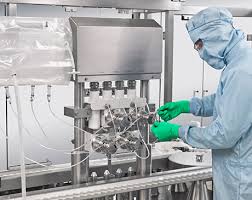In the pharmaceutical industry, a filling machine is used to accurately and hygienically dispense liquid or semi-liquid medications into bottles, vials, ampoules, or syringes. These machines are essential for ensuring dosage precision, contamination control, and compliance with industry regulations.

Key Functions in Pharma Applications
- Precision Dosing
Pharmaceutical filling machines are engineered for high accuracy, ensuring that each container receives the exact amount of liquid medication or solution. - Sterile Filling
To avoid contamination, these machines often operate in cleanroom environments and may use laminar airflow systems, sterile pathways, and sealed filling zones. - Versatility
They handle a variety of pharmaceutical products, including:- Oral syrups
- Injectable drugs
- Eye drops
- Diagnostic reagents
- Vaccines and biotech liquids
Types of Filling Machines Used in Pharmaceuticals
1. Peristaltic Filling Machines
Often used for small volumes and sensitive products. These machines use flexible tubing and rotating rollers to push the liquid, minimizing product exposure and cross-contamination.
2. Piston Fillers
Used for more viscous pharmaceutical products like gels or creams. They ensure precise volume control.
3. Vacuum Fillers
Help fill containers to a consistent level and reduce foaming—useful for certain bottle shapes or liquid types.
4. Time-Pressure and Gravity Fillers
Used in high-speed production lines for lower-viscosity products.
Additional Features for Pharma Compliance
- Bottle vacuum and air rinse systems for cleaning containers before filling
- Automated capping, sealing, and labeling integration
- CIP/SIP systems (Clean-in-Place / Sterilize-in-Place) for maintaining hygiene
- FDA and GMP-compliant materials and construction
Final Thoughts
Pharmaceutical filling machines are critical in ensuring that medicines and diagnostic solutions are packaged with precision, sterility, and reliability. With various machine types suited for different formulations and container sizes, these systems form the backbone of modern pharmaceutical manufacturing lines.